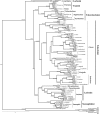Insect-bacteria parallel evolution in multiple-co-obligate-aphid association: a case in Lachninae (Hemiptera: Aphididae)
- PMID: 28860659
- PMCID: PMC5579299
- DOI: 10.1038/s41598-017-10761-9
Insect-bacteria parallel evolution in multiple-co-obligate-aphid association: a case in Lachninae (Hemiptera: Aphididae)
Abstract
Parallel phylogenies between aphid and its obligate symbiont Buchnera are hot topics which always focused on aphid lower taxonomic levels. Symbionts in the subfamily Lachninae are special. Buchnera in many lachnine species has undergone functional and genome size reduction that was replaced by other co-obligate symbionts. In this study, we constructed the phylogenetic relationships of Lachninae with a combined dataset of five genes sequenced from Buchnera to estimate the effects of a dual symbiotic system in the aphid-Buchnera cospeciation association. The phylogeny of Buchnera in Lachninae was well-resolved in the combined dataset. Each of the genera formed strongly supported monophyletic groups, with the exception of the genus Cinara. The phylogeny based on sequences from Buchnera was divided into five tribes according to the clades of the Lachninae hosts tree, with the phylogenies of Buchnera and Lachninae being generally congruent. These results first provided evidence of parallel evolution at the aphid subfamily level comprehensively and supported the view that topological congruence between the phylogenies of Buchnera and Lachninae would not be interfered with the other co-obligate symbionts, such as Sarretia, in aphid-entosymbiont association. These results also provided new insight in understanding host-plant coevolution in lachnine lineages.
Conflict of interest statement
The authors declare that they have no competing interests.
Figures



References
-
- Munson MA, Baumann P, Kinsey MG. Buchnera gen. nov. and Buchnera aphidicola sp. nov., a taxon consisting of the mycetocyte associated, primary endosymbionts of aphids. Int. J. Syst. Evol. Microbiol. 1991;41:566–568.
Publication types
MeSH terms
Substances
LinkOut - more resources
Full Text Sources
Other Literature Sources
Molecular Biology Databases

